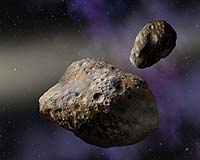 |
Los Angeles CA (SPX) Feb 15, 2010 Last month, a baseball-sized meteorite punched through the roof of a doctor's office in Lorton, Virginia, scattering insulation and ripping a hole in the carpet. What if it had been larger - much larger - and what if we knew in advance that it was coming? This month, The Planetary Society calls attention to the dangers our planet faces from near-Earth objects (NEOs) through announcement of the discovery of South America's largest known impact crater by a researcher funded by a Planetary Society grant, participation in a meeting in Vienna of the United Nations Action Team-14, and publication of a special issue of The Planetary Report on planetary defense.
Learning from Past Impacts In 2008, Rocca made contact with a group of geologists at the National University in Bogota, Colombia, who were studying the Vichada River region on behalf of mining companies. In cooperation with a colleague at Ohio State University, they examined the gravitational anomalies over the Vichada structure, confirming that Rocca's discovery was indeed an impact crater - at 50 kilometers in diameter, the largest in South America. "Rocca's dedication and perseverance in making new discoveries is something we are proud to support," said Louis Friedman, Executive Director of The Planetary Society. "The Planetary Society is will continue to harness international resources on Earth and in space to understand the nature and threat of Near-Earth objects." Working with World Leaders The United Nations Action Team-14 is a group within the UN COPUOS Scientific and Technical Subcommittee. It was established in 2001 to address the asteroid impact threat. Bruce Betts, The Planetary Society's Director of Projects, is attending the Vienna meeting, held February 12-16, 2010. "The Planetary Society is pleased to join UN Action Team 14 to work with the world on international strategies for working together on the near-Earth object threat," said Betts from Vienna.
Educating the Public Charlene Anderson, Editor of The Planetary Report, introduces the issue: "They have the potential to destroy civilization, and they whiz past our planet with alarming regularity. Sometimes we see them coming, and sometimes we don't. They are generically known as near-Earth objects (NEOs), commonly called asteroids and comets, and they pose a natural threat greater than any faced by our species in history. Fortunately for us, it's a threat we can do something about." Articles in the special planetary defense issue of The Planetary Report include "To Move an Asteroid" by William Ailor, "Protecting Earth: Whose Job Is It?" by Friedman, and "Turning Cosmic Diaster into Opportunity" by former shuttle astronaut, Tom Jones. The Planetary Society thanks the Secure World Foundation for its generous partnership in creating the special issue of The Planetary Report. The Planetary Society has been supporting NEO-related projects for nearly three decades, including the on-going Gene Shoemaker Near-Earth Object Grant program to support amateur observers, observers in developing countries, and professional astronomers who, with seed funding, can greatly contribute to NEO research.
Share This Article With Planet Earth
Related Links Gene Shoemaker NEO Grants at Planetary Society Asteroid and Comet Impact Danger To Earth - News and Science
 Experts Chart Steps For Global Asteroid Warning Network
Experts Chart Steps For Global Asteroid Warning NetworkWashington DC (SPX) Jan 29, 2010 A group of international experts has outlined steps to establish a global detection and warning network to deal with possible asteroid threats to Earth. An interdisciplinary group, including asteroid tracking specialists, space scientists, former astronauts, United Nations authorities, as well as disaster management, risk psychology and warning communication experts gathered to take part i ... read more |
|
| The content herein, unless otherwise known to be public domain, are Copyright 1995-2010 - SpaceDaily. AFP and UPI Wire Stories are copyright Agence France-Presse and United Press International. ESA Portal Reports are copyright European Space Agency. All NASA sourced material is public domain. Additional copyrights may apply in whole or part to other bona fide parties. Advertising does not imply endorsement,agreement or approval of any opinions, statements or information provided by SpaceDaily on any Web page published or hosted by SpaceDaily. Privacy Statement |